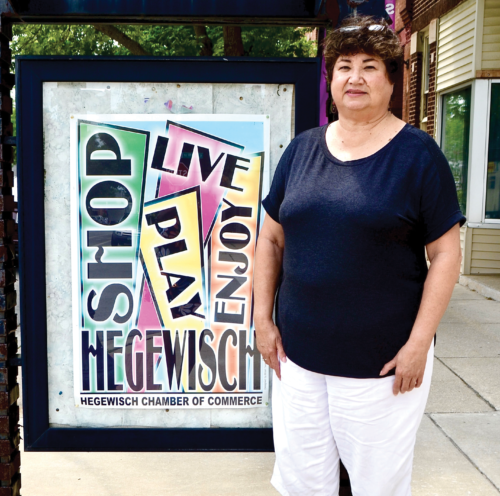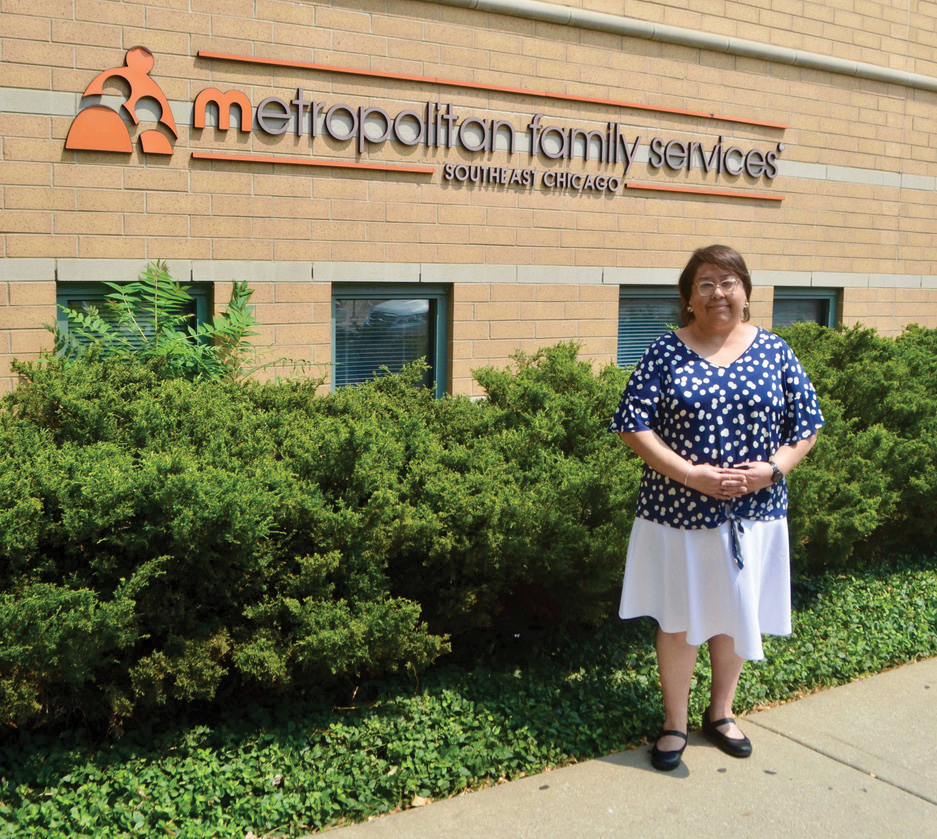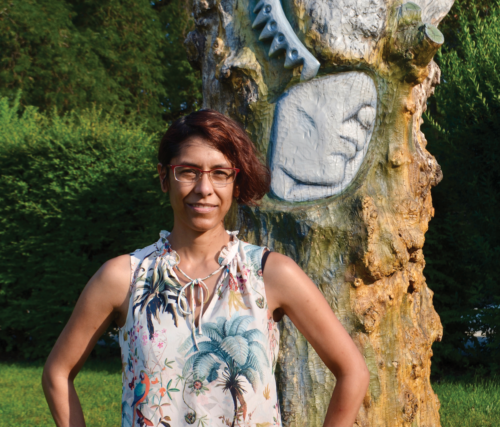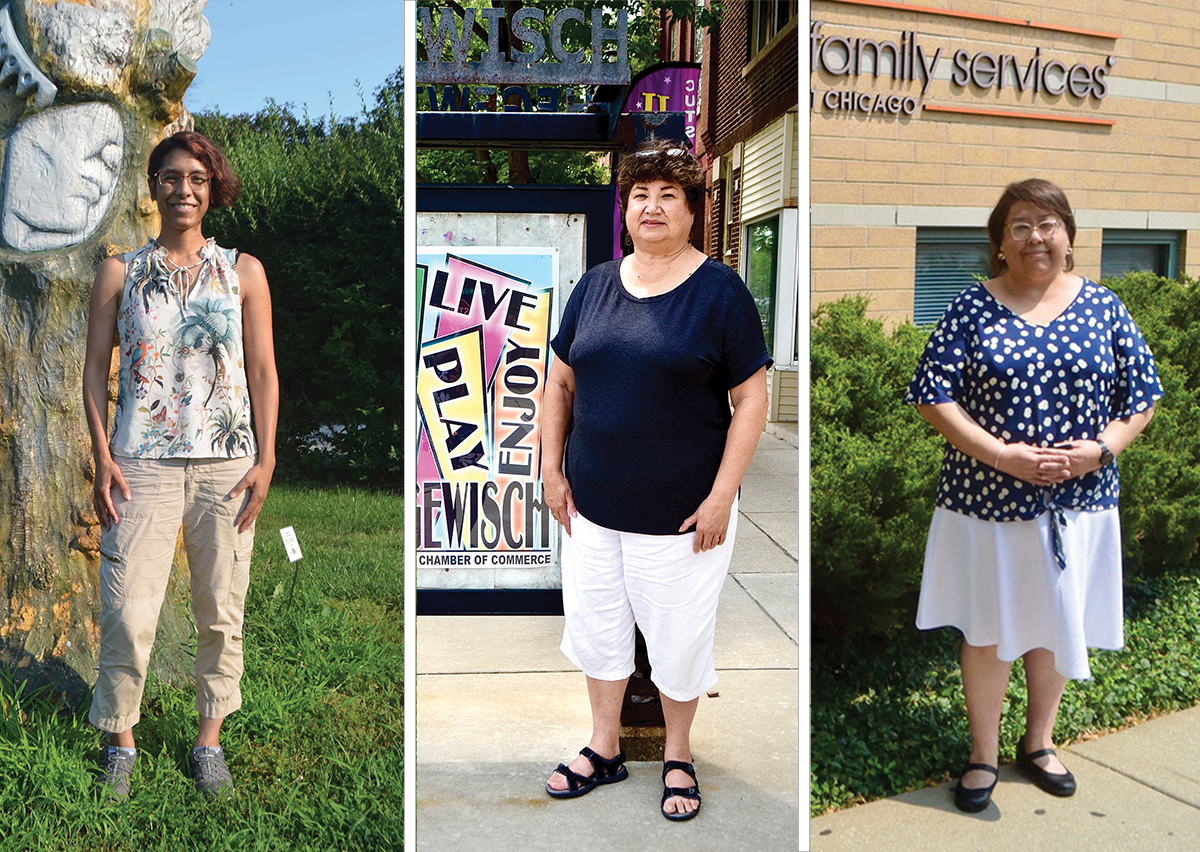When U.S. Steel South Works shuttered its doors in 1992, the Southeast Side was still a thriving community. Steel mill workers were paid enough to buy homes, send their children to college, and take vacations. Yet, the community’s place as a former industrial hub has also made it environmentally overburdened, and in addition to a lack of jobs, residents also face the result of generations of exposure to high levels of pollutants.
Peggy Salazar, Vanessa Schwartz, and Amalia NietoGomez know and understand these challenges. Their work, collectively and separately, addresses these needs. City Bureau fellow Bridget Vaughn interviewed them about the pollution the steel mills left behind, today’s environmental activism, and the most recent hurdle in a grassroots effort to stop a major company, General Iron, from moving a scrap metal plant to the area. The interviews have been edited for length and clarity.

Peggy Salazar
Peggy Salazar recently retired after ten years as the director of the Southeast Environmental Task Force (SETF). Before she was the director, Salazar served on the SETF Board for five years, a position she was recruited to after dedicating her time as a volunteer. She grew up across the street from the U.S. Steel plant, and her husband worked there for thirteen years.
How did you get involved with the Southeast Environmental Task Force?
I was always engaged in my community. Through that engagement, I would occasionally rub shoulders with the task force. One year, I was asked to become a volunteer or to be on the task force board. I said I’ve never been a board member. I’ll volunteer for a while and see how it goes. And before I knew it, I was a board member for five years and the director for ten years. I am not young. Presidents have term limits. I actually needed to have term limits too. It’s a good thing to bring in new people.
What impact has Chicago Mayor Lori Lightfoot had on environmental justice on the Southeast Side?
I had high hopes for her, but she inherited a lot of crap. You assume that she’s willing to take on whatever comes her way. It just seems to me, like right now she’s overwhelmed.
She did disappoint me. She came down here after she was elected. She held a meeting right here at the local high school. It was supposed to be about the budget, but then the floor opened for questions. Someone brought up the issue of General Iron moving to the Southeast Side. Mayor Lightfoot responded by informing the audience that General Iron was not moving to “your” neighborhood, only the assets are now.
I was disappointed in her. But, I also understand the position she was in because the developers on the North Side were on her big time. So, once again, did you not know you were walking into this? I don’t think she did.
She didn’t pay attention to our community being as active as it was. We had just gotten out of the coal gasification fight. We’ve just gotten out of the Petcoke fight. Maybe she thought we were worn down. But we weren’t going to give up.
What three things do you want people to know about the task force and you?
First, the task force is always going to be evolving to meet the needs of the community. What the task force does may be local in most cases, but those local changes have broader impacts.
Second, the task force, even if we made mistakes, we always thought we were doing the right thing. So even when we make mistakes, it’s not because we intentionally did something, it’s because we thought it was the right thing to do. I think that’s how the task force will always operate.
Third, I’m hoping we will be able to continue to engage the community and slowly build the people’s power. Keeping the community engaged and building on what you have. I’m also hoping to bring in some of the other neighborhoods like Jeffrey Manor.

Vanessa Schwartz
Vanessa Schwartz was born and raised in a working-class community on the Southeast Side. Her mother had a beauty shop and her dad worked for a steel manufacturer of retail items. Her grandmother was a nurse’s aide at LaRabida Hospital.
After college, Schwartz started her career working at a domestic violence shelter. For nearly three decades, she has served her community through her work with Metropolitan Family Services, where she currently serves as the executive director. By Schwartz’s estimate, approximately eighty-five percent of the families receiving services from the organization are at or below the poverty line.
So many people migrated and immigrated to the Southeast Side of Chicago looking for a better life. Did they find what they came for?
I think the steel mills were a generational kind of entity that really helped families to grow. The steel mills provided good paying jobs that really helped sustain families. As their children grew up, they also filtered into the steel mills as well.
And then paychecks from the steel mill jobs created opportunities for small businesses in the community to thrive. In its heyday, Commercial Avenue was bustling. I remember just walking down the street. It felt like walking downtown. Montgomery Wards was one of the anchor stores.
Our Lady of Guadalupe, which is down the street, is the oldest Mexican parish in Chicago. When we first came here, there were a lot of Eastern Europeans, and then Latinos came in, and then African Americans. Now it is a melting pot of multiple generations of people.
What are the health issues that Southeast Side residents experience by working at and/or living near the steel mills?
I know there’s a lot of asthma, bronchitis, upper respiratory illnesses and a lot of childhood cancer in this area.
There used to be, just down the street by the lake, humongous piles of petcoke [a byproduct of the oil refining process] that were not covered. So when you get really heavy winds that stuff would spray everywhere, and especially in the community. There was really no regulation on how to store that to protect the citizens. And then you’re looking right on the waterfront. So, of course that goes on the water, contaminating the water. You have a lot of people who would like to fish here and eat fish. I think my mom made a comment like, “Why would you eat that fish?” It was a polluted lake.
What do you remember about pollution growing up?
As a kid, I remember Saturday being a cleaning day. We would dust and then we would open the windows because we didn’t have air conditioning. By nighttime, it was all dusty again.
My dad would talk to a lot of residents because they were very upset that their yards and their houses were covered in this white soot. And I remember my dad coming home with that petcoke, like literally on his jeans or with that material in his boots and on his hands. And I remember him blowing his nose and you could see the white stuff. He worked there for fifty years. He retired in the early 2000s.

Amalia NietoGomez
Raised in a blue-collar family in California, Amalia NietoGomez has been an activist since she graduated from Princeton University. She found her way to Chicago to work on a housing campaign to stop predatory lending and got involved with local, statewide and national organizing. She remains actively involved with the Alliance of the Southeast as the organization’s executive director.
What brought you to Chicago?
I’d just come out of college and connected with the national organizing entity, National Training and Information Center, now known as People’s Action in Chicago.
I started working on a housing campaign to stop predatory mortgage lending. I ended up running a statewide coalition and getting the first city ordinance to stop the law on what defines predatory lending in Chicago. A year later, we got state regulations. The next year, we got a state law. And then, the following year the economy collapsed because of the housing bubble, which was caused by the predatory loans I had been working on.
What keeps me passionate is that the community has a voice in what’s going on, what’s important to them, and that they win what they want.
What are the challenges faced by the citizens of the Southeast Side?
Many challenges are rooted in the massive divestments in all of the communities. The Alliance of the Southeast covers the East Side, South Deering, Hegewisch and Park Calumet Heights. Those four neighborhoods also make up the 60617 zip code. We are one of the largest police precincts, the 4th District. And, we are one of the largest wards in the city.
One of the biggest things we are working on is the South Works development. When it is developed, it will be one of the largest developments in the Midwest, let alone Chicago. At one point, I knew they were predicting 100,000 jobs. That’s no joke. The South Works site is two and a half times the size of the Loop. That’s over 400 acres, which included 100 acres given to the Chicago Park District.
Take a look at the Lincoln Yards mixed-use development project that received $1 billion in tax increment financing (TIF) and compare it to South Works, seven times the size of Lincoln Yards. South Works received $119 million in TIF money. South Works is three times larger than Lincoln Yards. While it is purported to create 100,000 jobs, it’s not clear what percentage of jobs will be permanent. It’s a mix of permanent jobs and construction jobs, from the beginning of development to its completion.
What is the status of General Iron and its progress of moving to the Southeast Side, near Calumet Beach?
We’ve been working with a lot of really great organizations on the Southeast Side. We couldn’t have done it individually. Because of where things stand right now, we did have several wins. Our partners filed a complaint with the Department of Housing and Urban Development (HUD) and a federal complaint with the U.S. Environmental Protection Agency (EPA).
We had a big win with the EPA calling for the city to delay the permit indefinitely until environmental and health analyses are done. This was a big win. The city of Chicago actually agreed to hold off. It hasn’t moved forward. That’s a huge thing.
After they said they would hold off on their decision until the environmental and health analysis is done, General Iron filed a lawsuit suing the city for breach of contract. The complaint stated that the promise was breached. The victory came when the judge threw the case out. This is just the beginning. It’s not a permanent win where a decision has been made, but it’s definitely a win. Everyone was saying this is a done deal. I think it is very clear that it’s not. The decision has implications for other toxic developments.
Prior to working with City Bureau and the Weekly, Bridget successfully navigated the corporate and higher education sectors. She is an avid photographer and a diehard Chicago sports fan. One of her proudest moments was winning a 2019 Lisagor Award for The Narratives of Robeson High School, a podcast on the closure of Robeson High School in Englewood.


This article is interesting and informative. So much of this I did not know. Its always good to know what communities are doing to help themselves.